Interested in becoming a nomad? Imagine traveling the world leisurely, immersing yourself in diverse cultures and landscapes. But what about the cost?
Since 2016, my husband and I have been full-time nomads. When we sold our home and possessions, we had no clue how much this lifestyle would cost. Our only example was Nomadic Matt, who traveled solo for $50 per day. We used that as a starting point for our planning, knowing that some years would be less and others much more. How do you plan financially for a life of continuous travel? Let’s dive into the details.
Table of Contents
Click on your topic of interest
What’s included & What’s not
Lifestyle & Cost not included: Heath Insurance, Business Expenses, Travel Expenses
TOTAL COST CHART
Cost by Country/Region
Latin America, Antarctica, USA, Philippines, Australia, Europe, Morocco
You can see our travel timeline here.

What’s included & what’s not
Our Lifestyle
Everyone travels differently, and costs will vary. For us, experiencing nature and culture is paramount, and we’re willing to spend more on these experiences. We prioritize them over lodging and transportation, often opting for simpler accommodations and public transport—which we prefer—to immerse ourselves more deeply in the local culture.
Although we avoid luxury hotels and private vehicles, we indulge in experiences like a Galapagos cruise or an Antarctic expedition. Sometimes we upgrade for comfort. For example, in Australia, instead of a small van, we chose a larger, six-meter bus equipped with a queen-sized bed, kitchen, shower, toilet, and enough headroom to stand upright and walk around, enhancing our travel experience. We named the bus, our Australian home, Lil’ Beaut.
Cost not included Summary
One of the major financial concerns for U.S. citizens retiring early is health insurance and medical expenses. I have not included these costs in the charts below because healthcare costs can vary significantly based on age and country of origin.
We carry health insurance but not travel insurance, as we don’t see it as necessary. Our travel style seldom involves expensive flights, and when it does, we use our credit card, which provides some travel insurance coverage. We travel slowly, so delays don’t significantly affect us financially. The value of the items in our backpacks is likely less than what we would pay in travel insurance premiums. To safeguard against data loss, we use inexpensive Chromebooks in case they get lost, stolen, or damaged. All our data is in the cloud.
Business Expenses are not included as that is part of our investment portfolio. Nor is the cost of running this blog (currently around $100 a year).
Charity is not included.
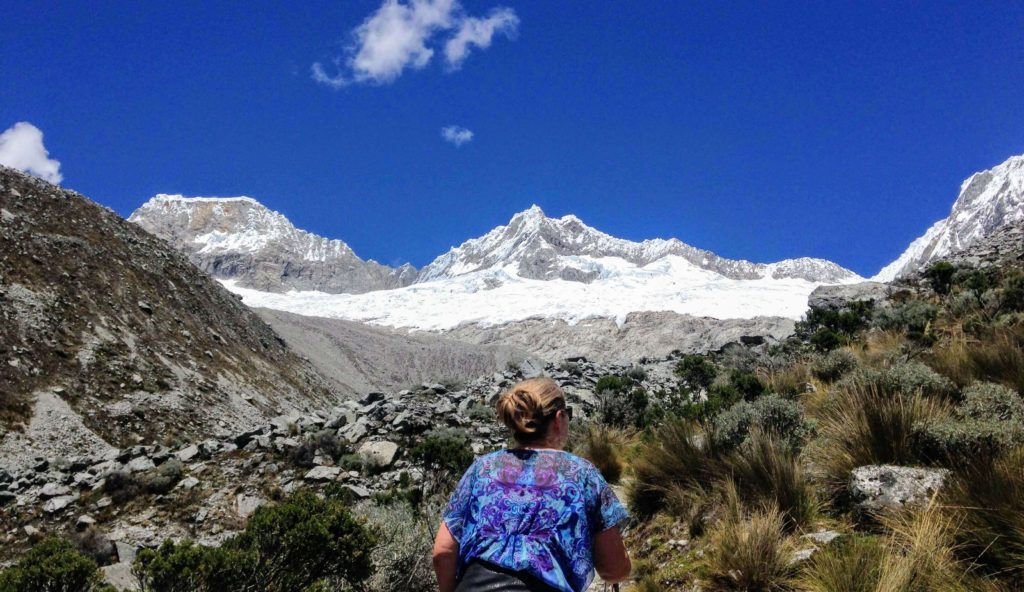
Health Insurance Details
We researched extensively and found that GeoBlue offered the best balance of coverage and cost for comprehensive health coverage. Our policy covered us globally, excluding the USA. This was beneficial when I needed knee surgery in Panama. GeoBlue covered everything beyond our deductible without a hassle and even paid for supplements to strengthen my knee.
While in the USA, we use a health share program, which isn’t traditional health insurance but still helps cover medical costs. Regular health insurance in the USA isn’t suitable for us because it typically requires using in-network services. Our visits to the USA include road trips to see all our friends and family from coast to coast and we are rarely within one network. Including the USA in our GeoBlue plan would double the cost. However, since we spend most of our time abroad—often more than a year at a stretch—switching between the two plans works for us.
Recently, we switched to IMG with a plan that has a $5 million cap. Since healthcare costs in Europe seldom exceed a million, we were comfortable moving away from GeoBlue’s unlimited cap. If we were living in the USA, where healthcare costs can escalate quickly, we would opt for a plan without a cap.
We do not carry dental insurance. Instead, we participate in medical tourism. Trin had two implants done in Costa Rica and I had a wisdom tooth removed in Sweden. The services have been world class and cost less than the premiums we would have paid for dental insurance in the USA. Dental cleaning in Nicaragua was $10.
Business Expenses
We own two LLCs that manage rental properties, handling all associated costs, including repairs, taxes, and fees. The business structure contains these expenses, and I typically only see them on the balance sheet since our property managers handle all operational details. We treat these LLCs as part of our diversified investment strategy. Given the variability in individual portfolios, I have not included details about these investments here. I am currently working on a book, but I have not included details about expenses related to publishing, such as formatting software and illustrator fees, in these charts.
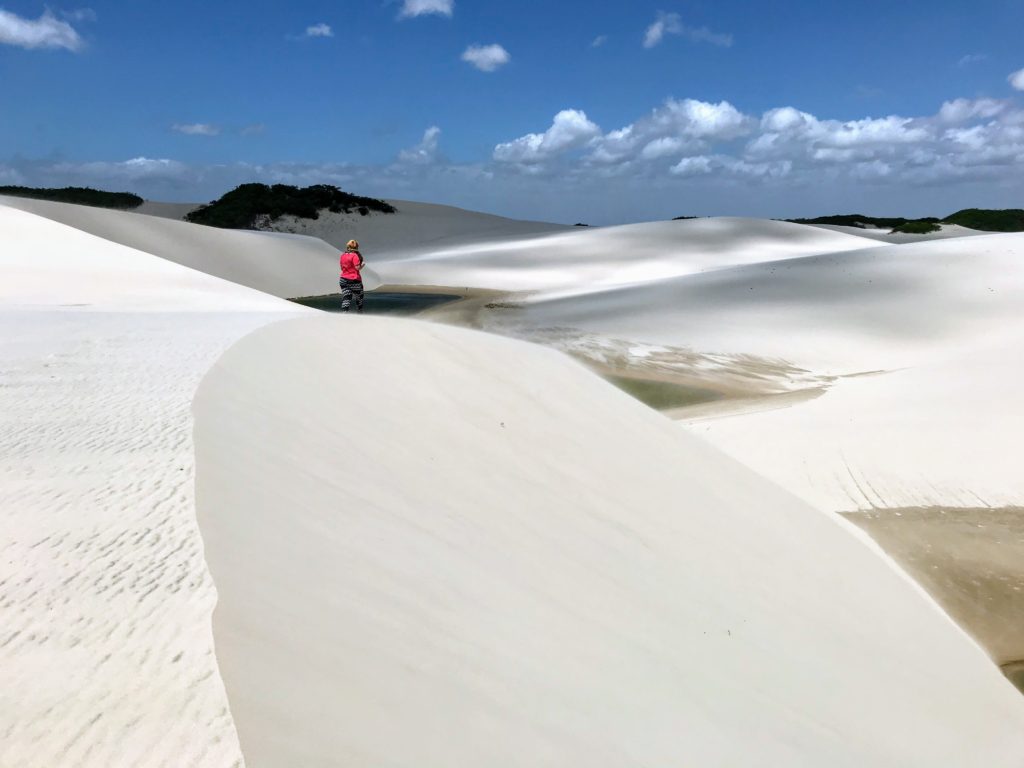
Travel expenses included
Since we don’t have a home address, we also don’t have utility bills, storage costs (we sold it all), or many of the monthly expenses that come with most lifestyles. Outside of business costs, which are all automated and within the LLCs mentioned above, health insurance is the only monthly fee we pay.
Since we don’t have a permanent home, we also avoid the costs associated with one, such as utility bills and storage fees—we sold everything. Apart from business expenses, which are automated and managed within our LLCs, our only regular payment is for health insurance. All our travel expenses fall into six categories: accommodation, food, entertainment (like swimming with whale sharks), transportation, technology, and personal (clothes, etc).

Total Cost
TOTAL COST CHART
The data below covers the period from October 2016 to March 2024. It excludes the 19 months we spent in the USA during these years. The chart below provides details about each continent and the associated costs.


In a few tiny countries, we spend considerably less time, so the costs appear to be higher as there was less downtime in these countries.

Cost by Country/Region
First-year overview
In many countries, we could beat the goal of less than $50 a day. We blew it out of the water during our first year. Of course, we were in super inexpensive countries that the first year, but it was a great start for us.
In most countries, we spent less than $50 a day far exceeding our goal during our first year. This was partly because we were in very inexpensive countries initially.
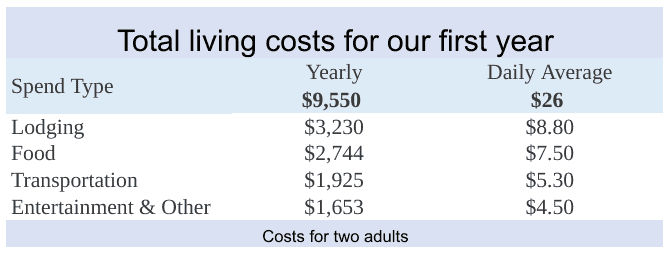
Latin America
We spent two years and four months backpacking across Central and South America, primarily staying in Airbnb and using public transportation. Staying in Airbnbs allowed us to cook most of our meals with local ingredients.
The chart below does not include our one-way airfare to Costa Rica, where our journey began. We also undertook a couple of volunteer stints that helped reduce our travel costs. I have provided detailed notes to prevent any misrepresentation of the planning costs for others in relation to these instances.

While we didn’t spend excessively, we thoroughly enjoyed our travels. Our adventures included a cruise in the Galapagos, hiking to Machu Picchu via an adventurous route, spending a month in the sacred valley, hiking the W trek to Torres del Paine, exploring deep into the Amazon jungle, scuba diving in Coiba with sharks, and much more.
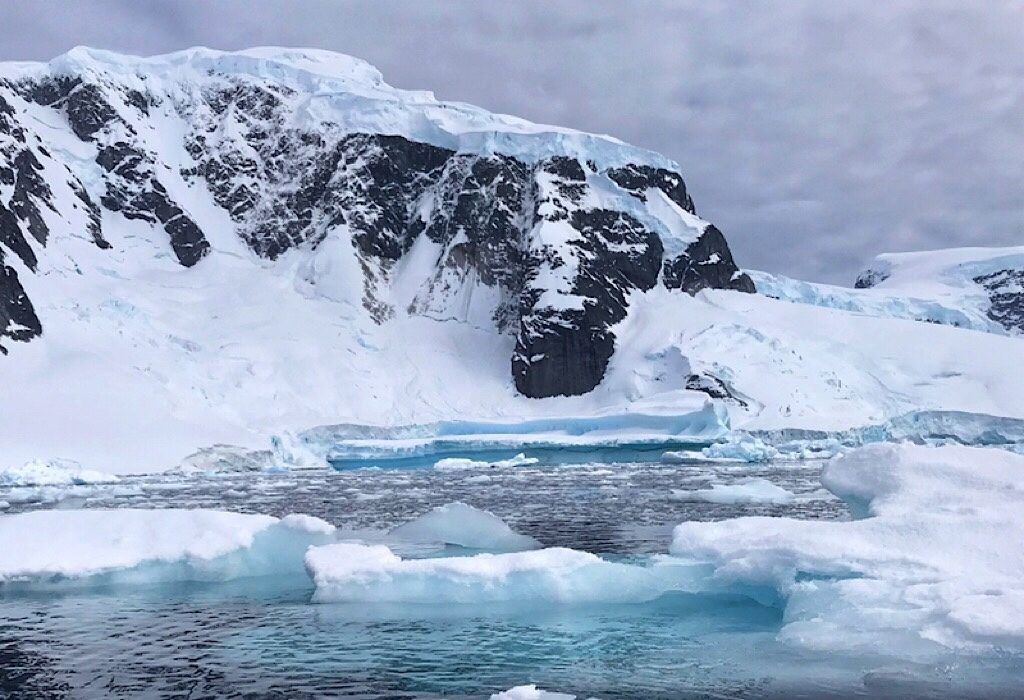
Antarctica
I just had to see Antarctica too and opted for a 22-day expedition that explored the Falklands and South Georgia on the way to Antarctica. Never have I witnessed something as amazing in my life. Opting for an expedition over a cruise was crucial for me; I wanted to actually set foot in Antarctica and walk among the penguins.

One of the best parts of travel is the people we meet, like David, an Arctic explorer who once drifted away on sea ice.
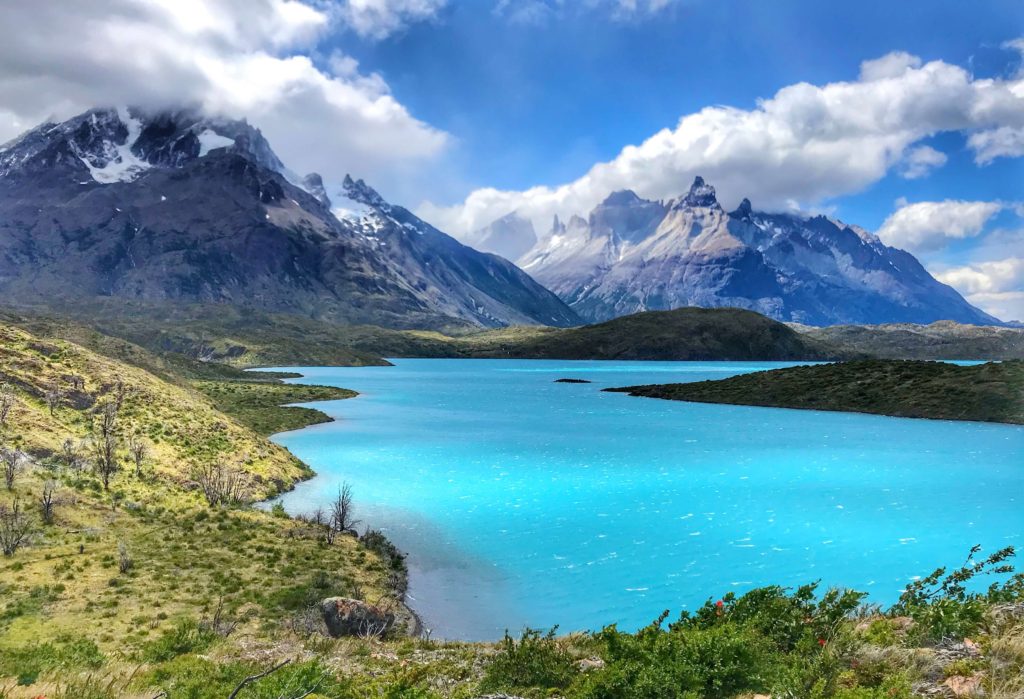
USA Visit
After traveling from Nicaragua to Antarctica, we returned to the USA for a four-month visit. During our stay, we bought a car in Arizona and drove it to the East Coast. Because Arizona cars lack rust, we sold the car in Pennsylvania (where many cars are rusty) for a price close to what we initially paid, thus recouping most of our investment.
When in the States, our priority is visiting friends and family, so we often stay with them as we travel through. I don’t meticulously track expenses in the USA, since they may not apply to other travelers. Another practice we have while in the USA is upgrading or replacing our laptops, phones, and any worn gear. Tech devices are cheaper in the USA. Our return flight to the USA from Santiago, Chile cost $545, reduced by using travel points from our fee-free Capital One Card.

Philippines
In the Philippines, we offset some of our accommodation costs by staying with family.

One of our favorite attractions in the Philippines was exploring the rice fields in Banaue, northern Luzon (pictured above).

Australia
In Australia, we found that purchasing an RV was the most cost-effective way to explore the continent. After much deliberation on the type of vehicle to buy, we settled on a converted Toyota Coaster, which we affectionately named Lil’ Beaut. It served as both our transportation and accommodation during our Big Lap around the continent.
Initially, upon arriving in Australia, we rented a couple of Airbnb’s and used public transportation until we acquired our motorhome. Traveling with Lil’ Beaut marked a distinct shift in our journey. To reflect this, I have divided our expenses into two categories: Renting and Owning.
- Renting includes getting to Australia from the Philippines and all living expenses before we purchased our Lil’ Beaut and after we sold her. To reduce these expenses, we did two house-sits after selling our bus.
- Owning included all living expenses while we were doing the Big Lap around Australia. It includes the purchase and sale of our bus and anything we spent in Australia while living in our Lil’ Beaut.

See Details about the costs of the Big Lap around the continent of Australia.
Europe
ACCESS DENIED! -Covid Relocation Debacle
Our initial attempt to enter Europe was unsuccessful. Fortunately, we spent most of the pandemic in Australia, where community transmission was minimal to nonexistent until we left in January 2021. Although we would have liked to stay longer, our Australian visa expired, forcing us to move.
We planned to settle in Finland near Trin’s sister for the rest of the pandemic. However, this turned into a three-part drama: first, our visa expired; then, Helsinki denied us entry, which led us to search for a place anywhere in the world to hunker down for the duration of the pandemic.

Finland didn’t work out, and interestingly, flying to the USA from Australia would have cost about the same, if not slightly more. The expense that still bothers me is the Airbnb payment, which was a total loss. While waiting for the gradual reopening of the world post-pandemic, we spent some time in the USA. There, I even accepted a job for the winter. By the spring of 2022, we were traveling again.
European Visa
Twenty-nine countries have collaborated to establish the Schengen Visa, which simplifies travel among them. There are no passport controls at the borders between these countries, and no separate visas are required for each country. However, the visa limits visitors to staying in the Schengen area for only 90 days within any 180-day period. Traveling around Europe requires us to hop in and out of the Schengen area every 90 days.
Below are our travel costs in 90-day (approx) segments as we travel in and out of the Schengen area.
Baltics & Sweden (in Schengen)
In May 2022, we flew to Poland to start our first 90-day Schengen visit. Then we explored the Baltics before flying to Sweden to visit Trin’s sister. I have not included the breakdown for Sweden below since there were minimal accommodation costs.

United Kingdom (out of Schengen)
We spent the last part of 2022 in the United Kingdom. By spending 69 days house-sitting in the stunning highlands of Scotland, we reduced overall accommodation costs. House-sitting usually reduces our total cost, but this time we offset them with a wee bit of damage on a rental car that we were liable for….oops. This additional little oops increases the Scottish transportation cost by $1,600.

At the end of 2023, we went back to the UK for a couple of months. The chart reflects aggregated costs per country.
Spain and Portugal (in Schengen)
During our second 90 stint within the Schengen area, we stayed in Spain and Portugal. The chart below lists the totals of what we spent. Click here for our favorite places in Spain and a detailed breakdown of associated spend.

Morocco (out of Schengen)
The Sahara desert in Morocco was breathtaking, and the stunning beauty of the gorges surprised us. From blue cities to the celebration of Eid-al-Adha, there is much to see and experience. Morocco permits U.S. visitors to stay 90 days. Almost perfect for our 90 days out of Schengen – except that travel days to and from Schengen count towards the visa in both areas. That would leave us short 2 days. To avoid visa issues, we spent two days in Ceuda, Spain – a tiny city on the tip of Morocco. We traveled to Ceuta overland, which allowed us to reset our 90-day visa for Morocco, extending our stay to 98 days.
Click here for details on the cost of Morocco and some of our favorite experiences.

Additional European Travel
After Morocco, we bounced around a bit, visiting some of the smaller countries like Luxembourg and the Holy See, staying anywhere from one to a few days. The total chart above includes the costs for these visits. Over the past year, my focus has shifted toward writing a book, but I plan to dedicate some time to writing about our favorite places. I will continue to track the costs for each country because the spreadsheets are just plain fun and a way for me to relax.
Slow Travel
Even with the mishaps and unknowns of slow full-time travel, it is a freedom that we love. It is not nearly as expensive as we thought it would be.
How much did you spend on your last vacation? Where did you go and what did you see?


Reading about all your adventures and then being able to “visit” the different countries through your eyes has been so much fun and a great experience. Keep up the great job.
Thank you Jackie!
Bonnie- well written and perfect info. Do you haveaGeoBlue referral link?
Thank you, Chris! I wish I had a referral link but they do not offer affiliation. Here is just a link to their website if you want to check it out https://www.geobluetravelinsurance.com/ I have been very happy with their service.
Great breakdown Bonnie! It’s especially interesting to see how your expenses differ across your various destinations and forms of travel. You and Trin certainly got a lot of bang for your buck in terms of experiences these past few years. 🥂 to the adventures that will lead to your next expense breakdown!
Thanks Paul!
I’ve only been to Costa Rica on the list of countries that you have. Long way for me to go.
Costa Rica is a great place to start. Happy travels!
Thanks for this summary. My wife and I also have been traveling the world since my retirement, but on a much larger budget. I would recommend trying out the Camino de Santiago. We hiked 450 miles on this adventure and you can read about it here: https://financialsuccessmd.com/my-camino-de-santiago-journey-a-fire-adventure/
I’m adding your article to next Monday’s Fawcett’s Favorites.
Thanks,
Dr. Cory S. Fawcett
Financial Success MD
Thank you! I will definitely check out your article. I have been researching the Camino de Santiago and have a few maps already. I’m always looking for more information on it so thank you for posting the link!